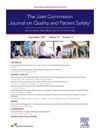Developing a Standardized Process to Visualize, Analyze, and Communicate NSQIP Data Using an Advanced Visual Data Analytics Tool
IF 2.4
Q2 HEALTH CARE SCIENCES & SERVICES
Joint Commission journal on quality and patient safety
Pub Date : 2025-01-16
DOI:10.1016/j.jcjq.2025.01.003
引用次数: 0
Abstract
Background
To help surgeons improve quality, the American College of Surgeons National Quality Improvement Program (ACS NSQIP) Semiannual Reports and Interim Semiannual Reports provide high-level views of 30-day morbidity and mortality rates. Surgeons at one hospital requested the ability to visualize data with interactive navigation and analysis of comorbidities monthly. Using advanced visual data analytics, the authors constructed a surgical scorecard to provide the desired feedback.
Methods
The authors undertook a proof-of-concept project tracking surgical site infections (SSIs) and associated medical comorbidities. An anonymized training dataset of 3,438 patients was sampled between January 1, 2021, and October 31, 2022, from the hospital's NSQIP data. For proof-of-concept interface/system testing and to maintain data privacy, a synthetic 5,000-patient NSQIP database was generated using the Synthetic Data Vault, Python 3.7. Comorbidity variables were: diabetes mellitus, HgbA1c, immunosuppressive therapy, hypertension requiring medication, body mass index, and smoking within one year. The primary outcome was SSI. The research team generated scorecards for SSIs as a function of time, surgical department, and medical comorbidity. Odds ratios with confidence intervals and chi-square tests were used to analyze the relationships between SSI and comorbidities.
Results
Advanced visual data analytics improved the timeliness of NSQIP Semiannual Reports and Interim Semiannual Reports from 6 months to 45 days. The scorecard allowed for visualization of data trends as a function of time, specialty, and procedural group. Statistical testing allowed for the identification of surgeons who were statistical outliers with regard to SSIs.
Conclusion
Implementation of an on-demand scorecard for data visualization and analysis allowed for up-to-date analysis of the relationship between medical comorbidities and SSI and identification of performance outliers.
使用先进的可视化数据分析工具开发标准化流程来可视化、分析和交流NSQIP数据。
背景:为了帮助外科医生提高手术质量,美国外科医师学会国家质量改进计划(ACS NSQIP)半年度报告和中期半年度报告提供了30天发病率和死亡率的高级视图。一家医院的外科医生要求每月通过交互式导航和合并症分析可视化数据的能力。使用先进的可视化数据分析,作者构建了一个手术记分卡来提供所需的反馈。方法:作者进行了一个概念验证项目,跟踪手术部位感染(ssi)和相关的医学合并症。在2021年1月1日至2022年10月31日期间,从该医院的NSQIP数据中抽取了3438名患者的匿名训练数据集。为了进行概念验证接口/系统测试并维护数据隐私,使用Python 3.7合成数据库生成了一个包含5000名患者的合成NSQIP数据库。合并症变量为:糖尿病、糖化血红蛋白、免疫抑制治疗、高血压用药、体重指数、一年内吸烟。主要结局为SSI。研究小组为ssi制作了记分卡,作为时间、手术部门和医疗合并症的函数。采用带置信区间的比值比和卡方检验分析SSI与合并症之间的关系。结果:先进的可视化数据分析将NSQIP半年度报告和中期半年度报告的时效性从6个月提高到45天。记分卡允许将数据趋势可视化为时间、专业和程序组的函数。统计检验允许识别在ssi方面属于统计异常值的外科医生。结论:采用按需记分卡进行数据可视化和分析,可以对医疗合并症与SSI之间的关系进行最新分析,并确定表现异常值。
本文章由计算机程序翻译,如有差异,请以英文原文为准。
求助全文
约1分钟内获得全文
求助全文
来源期刊

Joint Commission journal on quality and patient safety
HEALTH CARE SCIENCES & SERVICES-
CiteScore
3.80
自引率
4.30%
发文量
116
审稿时长
49 days
 求助内容:
求助内容: 应助结果提醒方式:
应助结果提醒方式:


